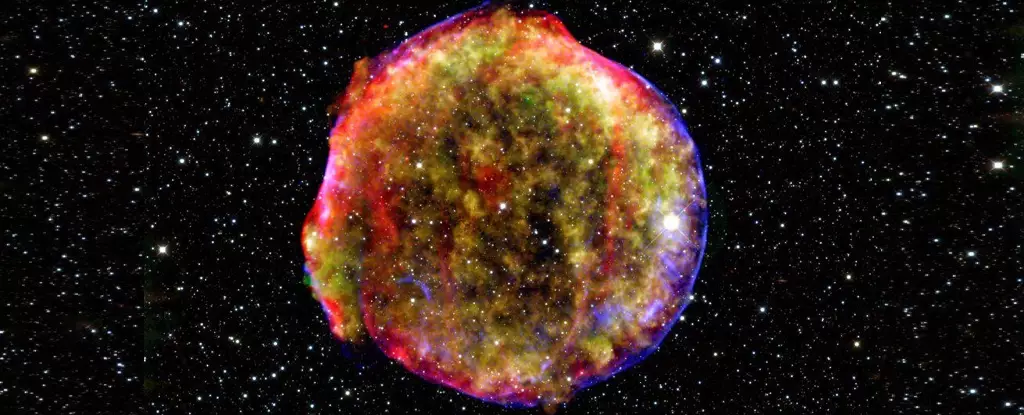In the grand theater of the universe, supernovae serve as dauntless protagonists, unleashing unimaginable forces that can launch atomic particles across the cosmos. For ages, humanity has looked upon the night sky, wondering if these stellar explosions might harbor the key to understanding cosmic rays—those mysterious streams of charged particles that invade our atmosphere. While supernovae have long held the status of potential cosmic accelerators, recent investigations have raised pertinent questions regarding their actual capacity to produce the most energetic cosmic rays.
The journey of probing cosmic rays is akin to deciphering an intricate puzzle. For over a century, scientists have dedicated their efforts to tracking these energetic particles, only to be met with the frustrating reality that their pathways are often obscured by the chaotic magnetic fields strewn across the Milky Way and beyond. This makes it exceedingly difficult to pinpoint the origins of these high-energy particles. Nevertheless, contemporary researchers remain undeterred, diving into the archives of stellar history—like the infamous Tycho’s star—to uncover the secrets of these celestial giants.
Tycho’s Legacy: The Bright Light in the Cosmic Mysteries
In 1572, the cosmos delivered a jaw-dropping spectacle with the emergence of Tycho’s star, a supernova that briefly transformed the night sky into a beacon of light. For modern astronomers, this historic event is not merely a fascinating anecdote but a potential cornerstone in their investigation into cosmic ray origins. A white dwarf nearing its demise, Tycho’s explosive finale was marked by a thermonuclear meltdown that sent ripples through the surrounding gases, intertwining stellar remnants with the otherwise empty vacuum of space. The critical revelation emerges as researchers scrutinize the magnetic fields generated from such cosmic cataclysms and find they may not possess the ferocity once anticipated.
A recent study highlighted the limited capacity of Tycho’s star to serve as an accelerator for cosmic rays, producing “significantly smaller” results than existing theoretical models had predicted. Yet this doesn’t completely dismiss the role of dying stars as possible accelerators; it does, however, implore us to rethink the extent of their potential power. In the cosmic game of particle acceleration, supernovae may not be the heavyweight contenders we once believed.
The Quest for the PeVatrons
Within this realm of investigation, astrophysicists have begun theorizing the existence of obscure cosmic engines known as PeVatrons, believed to be responsible for generating particles with energy levels beyond human technological capabilities—reaching peta-electronvolt (PeV) energies. Brimming with scientific ambition, researchers such as Robert Brose and his colleagues posit that the remnants of supernovae might just serve as the elusive PeVatrons. However, there’s a critical catch to this tantalizing possibility that hinges on timing and environmental conditions—the dying star must expel enough material post-explosion to create a dense shell around itself.
This shell, in turn, would facilitate the necessary turbulence from the expanding shock waves of the supernova, effectively launching atomic nuclei and electrons into cosmic overdrive. The temporal frailty is astounding; researchers argue that only the young remnants, within the crucial first few decades, will meet the required conditions for such extraordinary accelerations. Had Tycho’s star lingered longer in its stellar dance, we might have witnessed an explosion of energetic particles that could yield new insights into the enigmatic world of cosmic rays.
A New Dawn of Discovery
As we stand on the brink of discovering the hidden wonders of the universe, the universe remains teeming with possibilities. The study of cosmic rays and their origins through supernovae unveils a complex narrative, bridging the past with an uncharted future. With advancements in technology, we are more equipped than ever to harness the power of these cosmic phenomena, which may provide vital clues about the very fabric of our existence.
In the grand cosmos, a cataclysmic explosion of a nearby star could unveil the mystery of PeVatrons. As we peer into the celestial abyss, the violent demise of stars might illuminate the intricacies buried in the cosmic history, terrifying yet magnificent, forever altering our understanding of the universe we inhabit. Ultimately, the ethereal pursuit of knowledge empowers the human spirit to never relent, continuously searching for truth amidst the chaotic grandeur of existence.


Leave a Reply